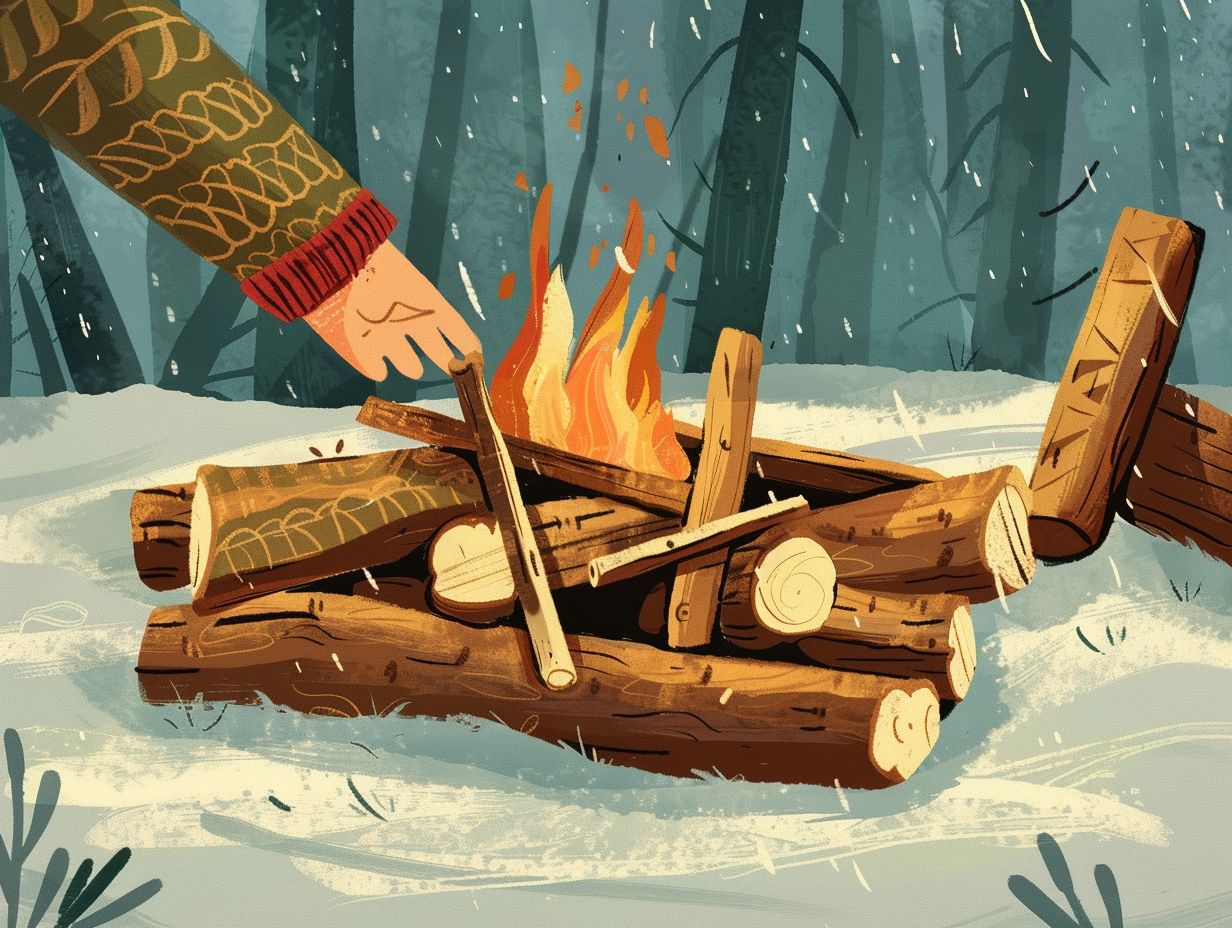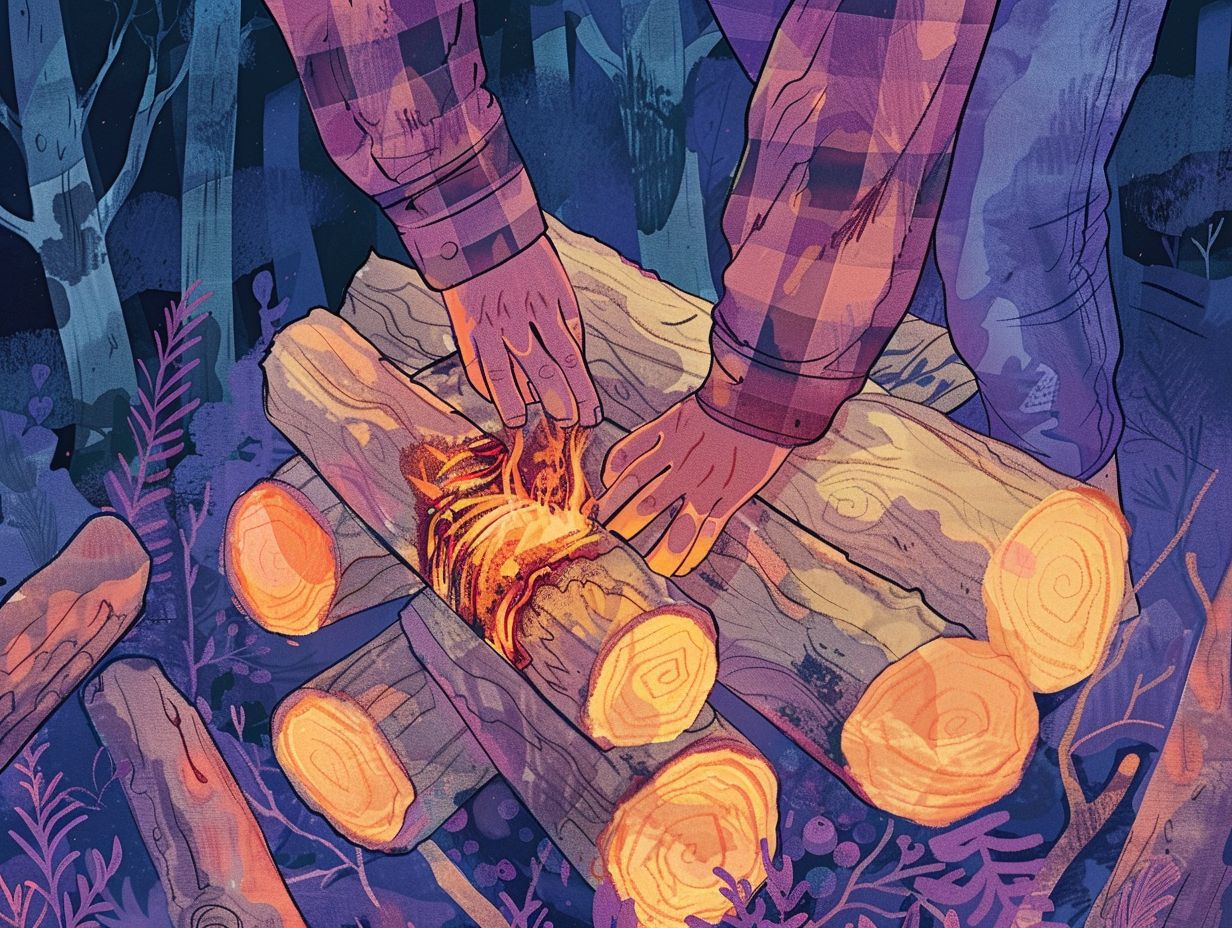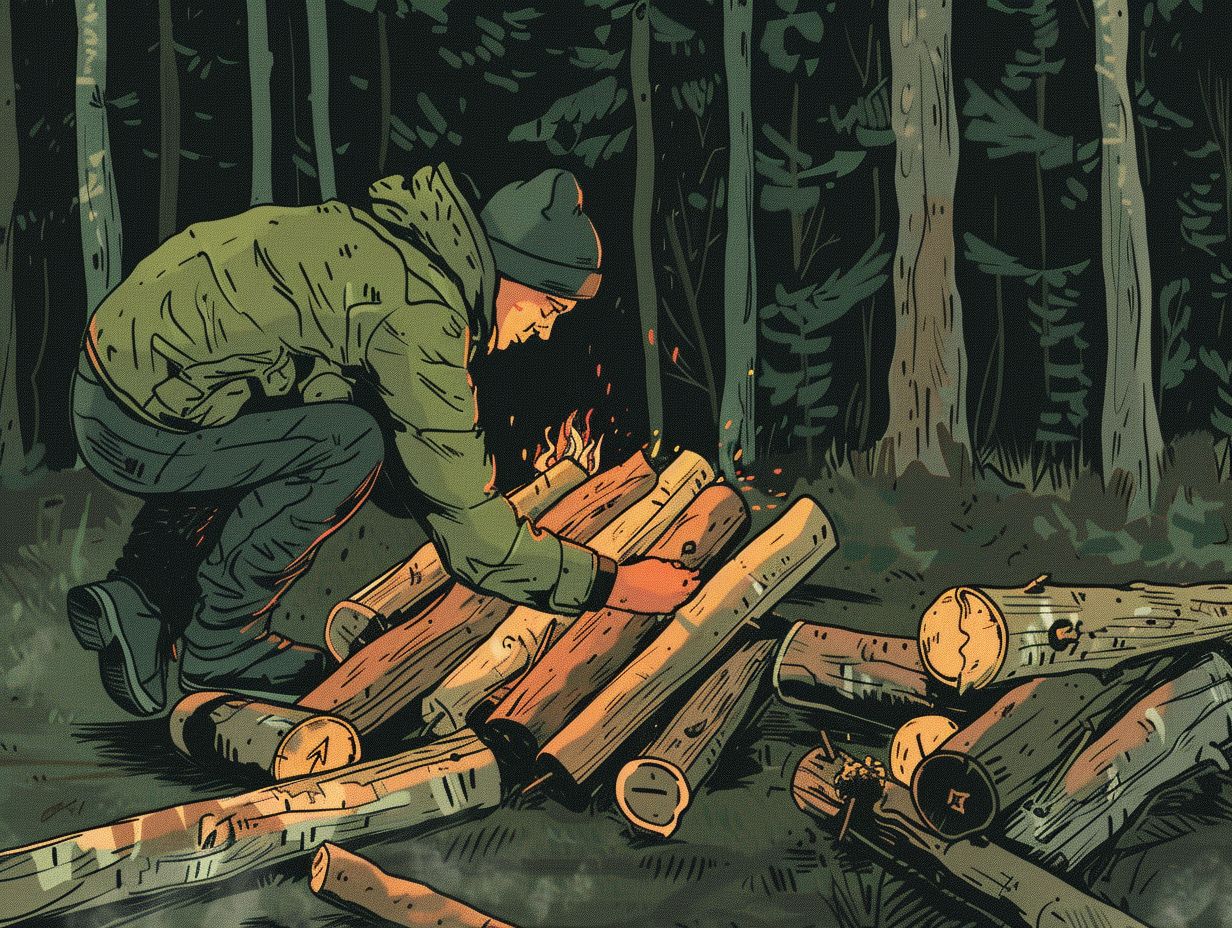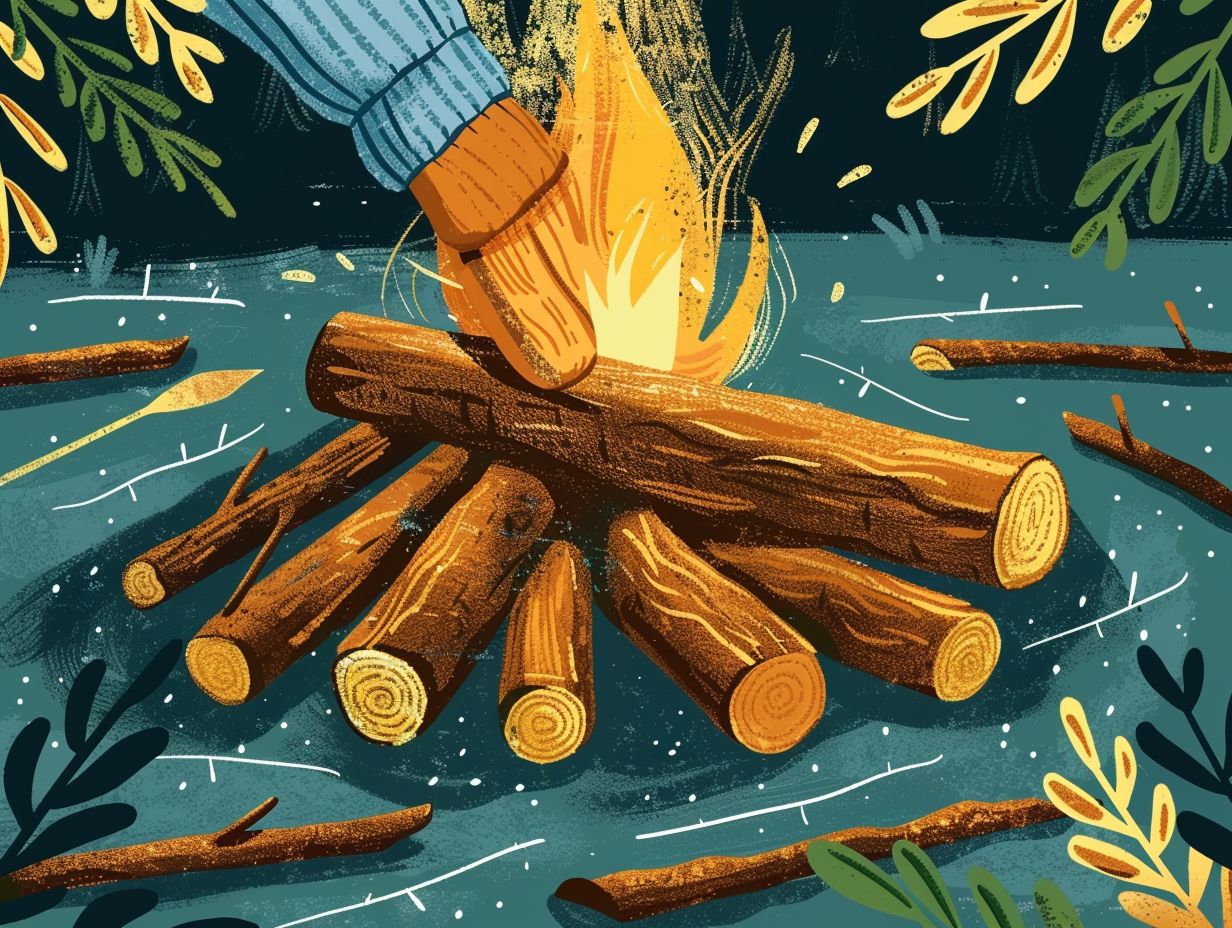Are you prepared to embrace the great outdoors and appreciate the warmth and camaraderie of a crackling campfire? Building a campfire is a crucial skill for any outdoor enthusiast. This guide will outline the necessary materials and tools, the steps to constructing a safe and effective campfire, and essential safety precautions to consider.
Grab your marshmallows and accompany us as we delve into the art of creating the ideal campfire.
Key Takeaways:

- Building a campfire is an essential outdoor skill that can provide warmth, light, and a sense of community.
- Gathering the right materials and tools, such as dry firewood and a shovel, is crucial for building a safe and successful campfire.
- Follow the step-by-step guide for building a campfire, which includes creating a fire pit, building the base, and safely lighting the firewood.
Why Knowing How to Build a Campfire is Important
Understanding the art of building a campfire is essential for any outdoor enthusiast like yourself, as it serves multiple purposes such as providing warmth, a cooking source, and a sense of security in the wilderness.
Mastering campfire skills will enhance your ability to engage with nature and practice crucial survival techniques that are critical for adventure camps or camping expeditions.
The sound of crackling flames, the comforting warmth it emits, and the captivating play of shadows cast against the night sky all contribute to the enchanting appeal of a well-constructed campfire.
Beyond its visual charm, a campfire holds significant importance in wilderness survival by offering not only physical heat but also emotional solace and a feeling of security.
Acquiring the knowledge of gathering suitable kindling, arranging the logs properly, and tending to the fire diligently can be the determining factor between a cosy night spent under the starry sky and a cold, uncomfortable one.
Materials and Tools Needed
For successfully start a campfire, you will require a range of materials and tools. These include kindling, wood of varying sizes to construct the fire in structures such as a wigwam, log cabin, platform, or star. Additionally, you will need essential tools for both creating and maintaining the fire. It is imperative to have the correct materials and tools in order to ensure a safe and enjoyable camping experience.
Gathering and Preparing Firewood
One of the critical steps in building a campfire is gathering and preparing the firewood. You need to collect dry kindling and suitable firewood to ensure a successful ignition and sustained fire.
When in national parks or KOA campgrounds, it is important to be mindful of regulations on firewood collection and use to protect the environment. Dry kindling, such as pine needles or small twigs, is crucial for starting the initial flame. Look for dead branches on the ground, ensuring they are not too damp. Opt for hardwoods like oak or maple for long-lasting, clean-burning fuel.
When gathering firewood, it is essential to avoid live trees or cutting standing dead trees, as this disrupts the ecosystem. It is best to source firewood locally or purchase it on-site to prevent the spread of pests and diseases. By following these guidelines, campers can enjoy a safe and environmentally conscious campfire experience.
Essential Tools for Building a Campfire

Having the right tools for building a campfire is essential for a safe and enjoyable experience. Tools such as matches, lighters, firelighters, and fire extinguishing equipment play a crucial role in igniting and extinguishing fires responsibly. Organisations like Boy Scouts and KOA Campsites often provide guidance on safe campfire practices.
These tools are not only useful for efficiently starting a fire but also for maintaining it at a manageable level. Understanding how to properly use these tools is crucial to prevent accidents and ensure the safety of everyone around the fire pit.
By following the campfire training from Boy Scouts and adhering to the fire guidelines of KOA campsites, campers can create memorable experiences without compromising safety.
Learning to control the fire’s size and having the necessary tools readily available can make a significant difference in preventing wildfires and preserving the natural surroundings while enjoying the warmth and camaraderie of a campfire.
Step-by-Step Guide to Building a Campfire
- Establish a proper fire pit and prepare the ground for the fire.
- Organize the firewood in configurations such as a teepee or lean-to.
- Properly ignite the fire to ensure a successful campfire experience.
Creating a Fire Pit and Preparing the Ground
Before you start a campfire, it is crucial to establish a designated fire pit and prepare the surrounding area. Ensuring that the fire pit is secure and properly contained is essential for preventing accidents and minimising the impact on the environment, particularly in areas like national parks where fire safety regulations are strictly enforced.
Creating a fire pit involves choosing a location that is clear of overhanging branches, dry grass, or any flammable materials. Clear the ground within a 10-foot radius of the fire pit from any debris and vegetation to establish a safety buffer.
Dig a pit about 6-8 inches deep and encircle it with rocks or a metal ring to contain the flames. Always keep a source of water nearby to fully extinguish the fire once you are finished. These measures not only ensure safety but also contribute to preserving the natural beauty of the park.
Building the Base of the Fire
Constructing a solid base for your fire is essential to ensure proper airflow and ignition. When layering wood in structures like the wigwam fire or incorporating kindling strategically, you can establish a stable foundation for your fire. Remember that knowing how to safely extinguish the fire after use is equally crucial.
Different fire structures, such as the log cabin and lean-to, require specific arrangements of wood to optimise burning efficiency. The log cabin structure, for example, involves stacking logs perpendicularly to allow sustained airflow. On the other hand, the lean-to structure requires leaning larger logs against a support to promote gradual combustion.
Understanding these variations can enhance your fire-building skills and ensure a reliable heat source. Always have a bucket of water or a fire extinguisher nearby for immediate response during emergencies or when extinguishing the fire at the end of its use. This proactive approach can help mitigate risks and ensure a safe fire management process.
Arranging and Lighting the Firewood

The final crucial step in building a campfire involves properly arranging and lighting the firewood. Whether you opt for a log cabin fire structure or a star fire layout, arranging the firewood for optimal ignition and sustained burning is essential for a successful campfire experience.
With the log cabin fire method, the firewood is stacked in a crisscross pattern to enhance airflow and promote ignition at the centre. Conversely, the star fire layout organises the wood in a radial pattern resembling spokes on a wheel, leading to a longer-lasting burn.
For efficient ignition of the firewood, it is recommended to follow sustainable practices by starting with small kindling and gradually incorporating larger pieces. This approach not only ensures a cleaner burn but also conserves the firewood for an extended period of campfire enjoyment.
Campfire Safety Tips
Ensuring campfire safety is crucial for protecting yourself, the environment, and those in your vicinity. It is imperative to adopt measures that prevent wildfires and adhere to correct fire extinguishing procedures to uphold a secure camping environment, particularly in areas overseen by the US National Park Service.
Preventing Wildfires and Protecting the Environment
Preventing wildfires and protecting the environment are closely tied to responsible campfire practices. To ensure the safety of wildlife habitats and preserve the natural beauty of outdoor spaces, it is important for you to be aware of fire regulations, show respect for the environment, and use proper fire building and extinguishing methods.
By prioritising fire safety guidelines, not only do you decrease the likelihood of devastating wildfires, but you also help cultivate a culture of environmental care among campers. Adhering to established rules such as maintaining small fires, utilising designated fire rings, and never leaving fires unattended allows individuals to actively participate in preserving ecosystems and wildlife diversity.
Incorporating Leave No Trace principles and conducting thorough clean-up after each campfire session demonstrates a dedication to sustainable camping practices that can be enjoyed by future generations.
Safe Practices for Putting Out a Campfire
Properly extinguishing a campfire is as crucial as building one safely for you. Follow specific protocols to ensure the fire is completely out and the ashes are cool to the touch, which is essential for preventing accidental fires or damage to the campsite. Learning these skills is fundamental for responsible camping practices at KOA campgrounds and beyond.
When you extinguish a campfire, start by allowing the wood to burn completely down to ash, ensuring that no flames are visible. Next, carefully pour water over the embers, stirring the mixture with a shovel to douse any remaining hot spots.
Continue this process until the hissing sounds cease, and the ashes feel cool. To enhance safety further, keep a bucket of water nearby during the entire process and NEVER leave a campfire unattended. By diligently following these steps, campers like you can enjoy their outdoor experience while upholding essential fire safety measures.
Frequently Asked Questions

1. What materials do I need to build a campfire?
To build a campfire, you will need dry and flammable materials such as small sticks, twigs, and logs. It’s also important to have a lighter or matches on hand to start the fire.
2. How do I choose the right location to build a campfire?
When selecting a location for your campfire, make sure it is in a safe and open area away from any flammable objects like tents or trees. Also, check for any fire regulations or restrictions in the area.
3. What is the first step in building a campfire?
The first step is to create a fire bed by clearing away any leaves, grass, or debris from the ground. This will help contain the fire and prevent it from spreading.
4. How do I arrange the materials for my campfire?
Start by placing a small bundle of tinder (dry leaves, bark, or paper) in the center of the fire bed. Then, arrange sticks and twigs in a teepee shape over the tinder, leaving enough space for air to circulate.
5. How do I light the campfire?
Using a lighter or matches, carefully light the tinder from the bottom. As the fire grows, add more wood gradually, starting with smaller sticks and gradually adding larger logs.
6. How do I safely extinguish a campfire?
To extinguish a campfire, pour water on the embers and stir them with a stick or shovel until the fire is completely out. Repeat this process until the fire bed is cool to the touch. Never leave a campfire unattended or use dirt to put it out.



